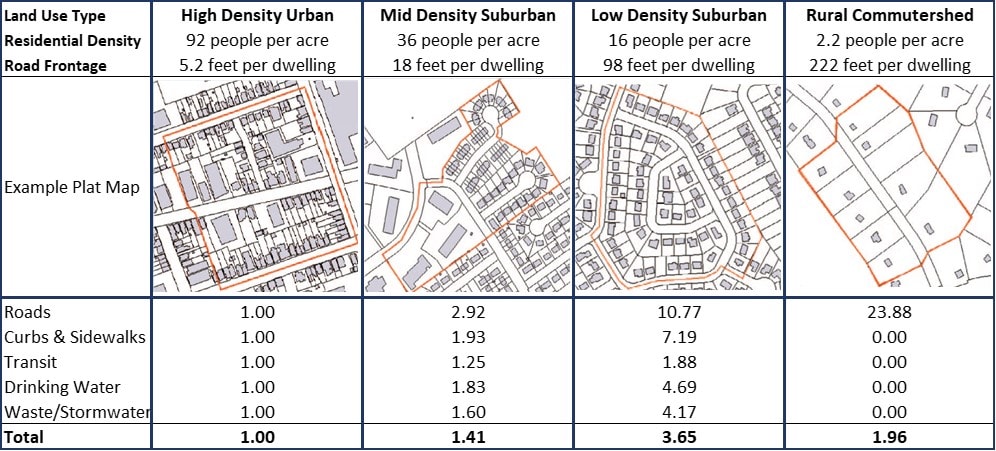In a Nutshell
- Sprawling auto-oriented cities incur more costs per resident to deliver infrastructure, utilities, and public services.
- Municipalities would benefit from calculating cost of services related to density and land-use type when evaluating the fiscal sustainability of new developments.
- Halloween provides an opportunity to intuitively observe what makes for sustainable development. Neighborhoods that are “trick-or-treatable” provide an example of development patterns that support social and economic health of a city and its residents.
By Eric Paul Dennis, PE – epdennis@crcmich.org
The Citizens Research Council recently published a report on Michigan’s Infrastructure Challenges and Opportunities. A core finding of this report is that many of Michigan’s infrastructure funding challenges relate to the state’s embrace of suburban “sprawl” development. The low-density land-use patterns that have been adopted in recent decades space homes and businesses further apart, while many of our previously dense urban areas have lost substantial population. A 2003 report from the Michigan Land Use Leadership Council found that, “the state of Michigan develops its land eight times faster than its population grows.”
As a result, Michigan residents are now responsible for more infrastructure per person than in previous decades. This requires higher taxes and utility fees to build and maintain the infrastructure. For example, the average Michigander’s water bill has more than doubled since 1980 and still does not cover the cost of service. As Michigan strategizes to grow and retain population, we must prioritize land-use patterns where the revenues derived from taxes and utility fees cover the cost of providing public services to the development.
Unfortunately, there are simply too many variables to derive typical costs. Individual municipalities will have to consider their unique situations when creating zoning codes, adopting land-use plans, and approving new developments.
However, as a general rule, the more spread-out and sprawling a city is, the more expensive it is to build and maintain public infrastructure.
Too often, public agencies assume that all growth is economically beneficial. But if that growth cannot create revenue that funds the long-term costs of infrastructure and other public services, new development can impose financial strains on the community. Local governments must assess their unique situations to determine what kind of growth they can afford.
An excellent example of such an assessment has been provided by the Halifax Regional Municipality in Nova Scotia, Canada: “Settlement Pattern and Form with Service Cost Analysis.” Halifax assessed the cost of service provision for various residential land-use patterns, from high-density urban to low-density rural development. The table below is derived from the report and presents the municipality’s estimated per-household infrastructure service costs based on different development patterns. The cost estimates have been baselined to the cost of delivering infrastructure to urban high-density land-use.
Table: Halifax Settlement Pattern Cost Analysis. Values reflect life-cycle infrastructure costs relative to high-density urban neighborhoods–the most cost-efficient development pattern.

Source: Halifax Regional Municipality
Halifax’s assessment of its built environment shows that the municipal government can most-efficiently deliver infrastructure and services to the densest developments. As land use becomes less dense, and buildings and residences are spread farther apart, more infrastructure is needed, with substantially more corresponding costs to deliver services to each resident.
For example, the table shows that building road pavement for a mid-density suburban area costs nearly three times as much as the dense neighborhoods (292 percent). For low-density suburban areas, road construction and maintenance costs over ten times more. In rural areas with homes built on one-acre lots, the cost of roads is nearly 24 times the cost per resident as the dense urban neighborhoods. Other infrastructure types also balloon in costs per resident as density decreases. With only these infrastructure elements considered, the mid-density suburban environment costs 41 percent more per resident. For low-density suburban, the cost is 265 percent more.
Notably, Halifax estimates the cost for a rural commutershed (where each lot is about an acre) is less than the low-density suburban area. But this is because the city assumes that it is not building-out sidewalks and water infrastructure to the area, nor is it providing public transit. That means that these residents have access to fewer services, and must cover the costs of their own water and sewer delivery by installing and maintaining private wells and septic systems. Yet, due to the cost of road infrastructure alone, Halifax’s rural areas require nearly twice the cost per resident as the dense urban area.
These calculations are very context-dependent and will look different for every unique municipality. Determining costs and affordability will require each municipality to conduct a similar study on their own system. However, there is an intuitive way that anyone can determine if a development is built in a way that can affordably deliver infrastructure and services: Halloween!
Each Halloween, trick-or-treaters descend on neighborhoods in search of free candy. Kids know that there are some neighborhoods that are better than others. Children’s goal of hitting as many houses as possible before the jack-o-lanterns go out reflects the municipalities goals of delivering infrastructure and services as efficiently as possible. The urban planner Brent Toderian has dubbed this the “trick-or-treat’ test.
Anyone who’s ever been trick-or-treating intuitively understands what makes a good street. Houses are close together, with inviting front porches set not too far from the street. There are good, connected sidewalks; or the street itself is relatively narrow, discouraging fast-moving traffic. There are short, walkable connections to other similarly trick-or-treatable neighborhoods. In a virtuous cycle of land-use driving civic engagement, participation from neighbors is high, with the porch light on at nearly every house! Many parents even drive their kids from low-density suburban neighborhoods to take advantage of these hallowed candy lanes.
Considering the correlation between affordable development and trick-or-treat-ability, there is a good chance that the trick-or-treat-able neighborhoods are far more efficient for public infrastructure and service delivery, while the dark suburban neighborhoods are costing the city more to maintain than the city derives from revenue. Another way to think about this is that if you are driving your kids to another part of your city to go trick-or-treating, that part of the city is likely subsidizing not only your children’s cavities, but also your low-density lifestyle.
This is not a moral or aesthetic argument about how people choose to live and the homes they choose to buy. This is a financial argument. Michigan is widely agreed to have underfunded infrastructure for the past several decades. We’ve actually been steadily increasing spending on all kinds of infrastructure and public services, but the cost to deliver these services has exceeded the capacity to fund infrastructure and public services as development patterns become more spread out, less dense, less trick-or-treatable.
Furthermore, the continued build-out of suburban sprawl has not occurred merely as a matter of homebuyers voting with their feet. A range of public policies from national highway policy to local economic development policies have subsidized this unsustainable sprawl. For example:
- More than 1,800 units of local government have legal authority to engage in land use planning and/or zoning in Michigan. Moreover, there is little planning coordination between units of government. This lack of coordination across jurisdiction and between governmental entities encourages a checkerboard pattern of development across the state.
- Local zoning codes for single family homes and land divisions in ten acre parcels result in low density, scattered development that reduce economic and environmental sustainability of both residential and agricultural land.
- Local and state investments often prioritize greenfield development over brownfields and infill.
- State environmental policy allows landowners to leave harmful pollutants in place, resulting in thousands of brownfield sites in dense areas with restrictive covenants that limit development potential.
- Michigan’s property tax policy incentivizes sprawl by limiting revenue growth of existing developments, requiring urbanized communities to increase tax rates, and prompting greenfield development in rural townships.
- State and federal highway policy have catalyzed and facilitated outmigration from city centers by constructing high-speed highways and arterials to exurban regions.
To achieve a sustainable state economy, restore our neighborhoods, and grow our population, we must emphasize in-fill development in areas with existing infrastructure that can accommodate it, rather than dig ourselves deeper into a hole by continually building new low-density, auto-oriented development on the urban periphery. We must also emphasize building “missing middle” housing types, including duplexes, townhouses, and low-rise mixed use developments.
Cities would be wise to assess their own land-use patterns and subsequent costs, similar to the Halifax example. In the meantime, Halloween offers a golden opportunity to recognize the development types we should be aiming for. The same attributes that make for a fiscally sustainable neighborhood also make for a trick-or-treatable neighborhood, which is something even a child can understand.
Related Posts from CRC
Michigan’s Path to a Prosperous Future: Infrastructure Challenges and Opportunities (2023)

